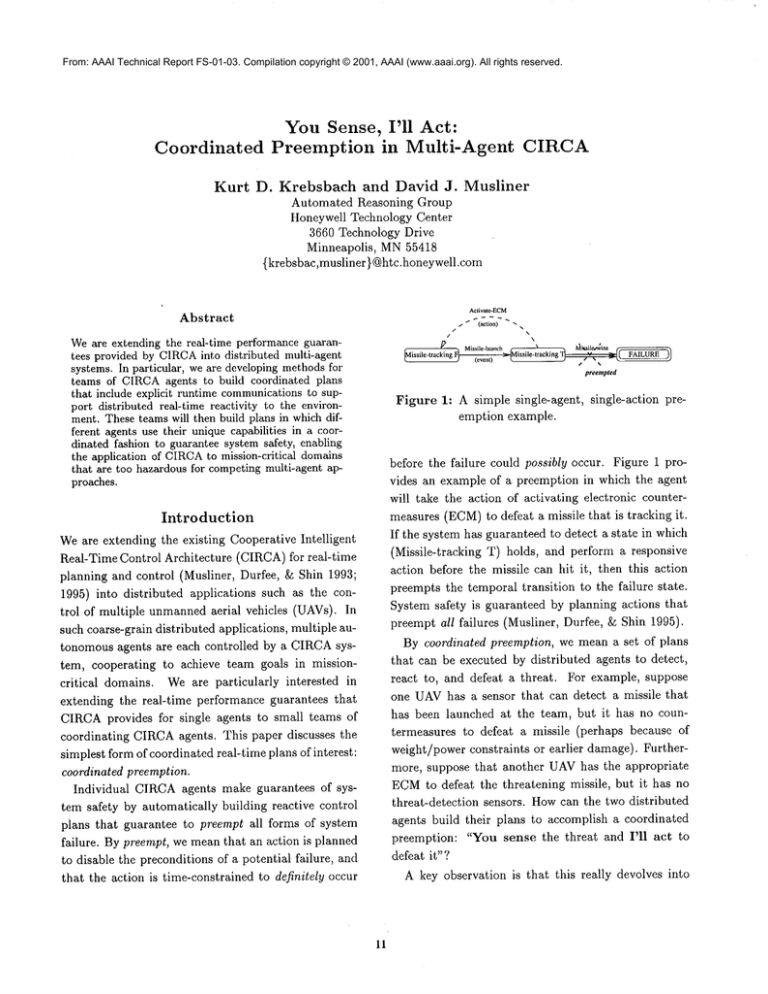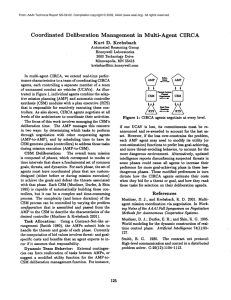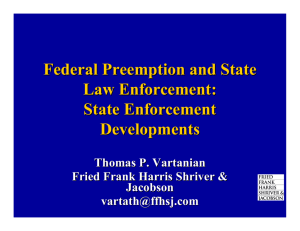
From: AAAI Technical Report FS-01-03. Compilation copyright © 2001, AAAI (www.aaai.org). All rights reserved.
Coordinated
Kurt
You Sense, I’ll Act:
Preemption in Multi-Agent
CIRCA
D. Krebsbach
and David J. Musliner
Automated Reasoning Group
Honeywell Technology Center
3660 Technology Drive
Minneapolis, MN55418
{krebsbac,musliner}@htc.honeywell.com
Aclivate-ECM
Abstract
/
/
/
(action) ~ ~ ,,
\
\
"~
~issile~ins
~"
~
~fMissile-tracking
~,,1is sile -t rackin g I~/Missile-launch
(event) ~,
J
z ¢ ~ ,, - ~
preempted
Weare extending the real-time performance guarantees provided by CIRCA
into distributed multi-agent
systems. In particular, we are developing methodsfor
teams of CIRCAagents to build coordinated plans
that include explicit runtime communicationsto support distributed real-time reactivity to the environment. Theseteams will then build plans in which different agents use their unique capabilities in a coordinated fashion to guarantee system safety, enabling
the application of CIRCA
to mission-critical domains
that are too hazardous for competingmulti-agent approaches.
Figure 1: A simple single-agent,
emption example.
~(~
single-action
’
pre-
before the failure could possibly occur. Figure 1 provides an example of a preemption in which the agent
will take the action of activating electronic countermeasures (ECM)to defeat a missile that is tracking it.
If the system has guaranteed to detect a state in which
(Missile-tracking T) holds, and perform a responsive
action before the missile can hit it, then this action
preempts the temporal transition to the failure state.
System safety is guaranteed by planning actions that
preempt all failures (Musliner, Durfee, & Shin 1995).
By coordinated preemption, we mean a set of plans
that can be executed by distributed agents to detect,
react to, and defeat a threat. For example, suppose
one UAVhas a sensor that can detect a missile that
has been launched at the team, but it has no countermeasures to defeat a missile (perhaps because of
weight/power constraints or earlier damage). Furthermore, suppose that another UAVhas the appropriate
ECMto defeat the threatening missile, but it has no
threat-detection sensors. Howcan the two distributed
agents build their plans to accomplish a coordinated
preemption: "You sense the threat and I’ll act to
defeat it"?
A key observation is that this really devolves into
Introduction
Weare extending the existing Cooperative Intelligent
Real-Time Control Architecture (CIRCA)for real-time
planning and control (Musliner, Durfee, ~z Shin 1993;
1995) into distributed applications such as the control of multiple unmannedaerial vehicles (UAVs).
such coarse-grain distributed applications, multiple autonomous agents are each controlled by a CIRCAsystem, cooperating to achieve team goals in missioncritical domains. Weare particularly interested in
extending the real-time performance guarantees that
CIRCAprovides for single agents to small teams of
coordinating CIRCAagents. This paper discusses the
simplest form of coordinated real-time plans of interest:
coordinated preemption.
Individual CIRCAagents make guarantees of system safety by automatically building reactive control
plans that guarantee to preempt all forms of system
failure. By preempt, we mean that an action is planned
to disable the preconditions of a potential failure, and
that the action is time-constrained to definitely occur
11
two separate issues:
Planned communicationThe agents must recognize the need to explicitly
communicate (both
sending and receiving) at a rate fast enough to satisfy the coordinated preemption timing constraint.
In our example, the sensing agent must agree not
only to detect the missile fast enough, but also to
tell the other agent about the threat soon enough.
Likewise, the acting agent must focus sufficient attention on "listening" for a messagefrom the sensing
agent often enough that it can guarantee to both receive the message and react to defeat the threat, all
before the deadline.
Distributed causal links -- The distributed agents
must be able to represent and reason about changes
to their world that are not directly under their control, but which are predictable enough to be relied
upon for a preemption guarantee. For example, in
our scenario, the sensing agent must rely on the acting agent to take the appropriate action in time to
guarantee to detect the missile threat.
Brief
Feedback
Data
Problem
Configurations
~ Subgoals,
Controller
Synthesis
Module
~/X~ A F Reactive Plans
Feedback Data ~Real~
/Subsy’:tem~
) The World
Figure 2: The CIP~CAarchitecture combines intelligent planning and adaptation with realtime performance guarantees.
reaction set has been developed, it can be downloaded
to the RTS.
CIRCA’s planning system builds reaction plans
based on a world model and a set of formally-defined
safety conditions that must be satisfied by feasible
plans (Goldman et al. 1997). To describe a domain
to CIRCA,the user inputs a set of transition descriptions that implicitly define the set of reachable states.
The CSMreasons about transitions of four types:
Overview of CIRCA
CIRCAuses a suite of planning and scheduling components to reason about high-level problems that require
powerful but potentially unbounded AI methods, while
a separate real-time subsystem (RTS) reactively executes the automatically-generated plans and enforces
guaranteed response times (Musliner, Durfee, & Shin
1993; 1995; Musliner et al. 1998). The Adaptive Mission Planner (AMP)and Controller Synthesis Module
(CSM)cooperate to build executable reaction plans
that will assure system safety and attempt to achieve
system goals when executed by the RTS.
CIRCA’splanning and execution subsystems operate in parallel. As illustrated in Figure 2, the Controller Synthesis Module reasons about an internal
model of the world and dynamically programs the RTS
with a planned set of reactions. While the RTSis executing those reactions, ensuring that the system avoids
failure, the other system components continue planning to find the next appropriate set of reactions. The
derivation of this new set of reactions does not need
to meet a hard deadline, because the reactions concurrently executing on the RTSwill continue handling all
situations,
maintaining system safety. Whenthe new
Action transitions
represent actions performed by
the RTS. These parallel the operators of a conventional planning system. Associated with each action
is a worst case execution time (wcet): an upper bound
on the delay (A(a) < T) before the action completes.
Temporal transitions
represent uncontrollable processes, some of which may need to be preempted.
Associated with each temporal transition is a lower
bound on the delay before the temporal transition
could possibly occur (A(tt) > T). Transition delays
with a lower bound of zero are referred to as Events,
and are handled specially for efficiency reasons.
Reliable temporal transitions
represent continuous processes that may need to be employed by the
CIRCAagent. For example, a CIRCAagent might
12
#<Singleagent TAP>
Tests:(MISSILE-TRACKING
T)
Acts : ACTIVATE-ECM
TA’P1
I TA’P=
[ TA’P*
I TA’P3
I T’P*I TA’P4
Figure
Figure 3: Single agent Test-Action Pair to activate
ECMwhena missileistrackingthe
agent.
turn on a piece of equipmentto initiate the process of
warming up that equipment. The action itself will
take a relatively short period of time to complete,
however, the warming process might complete after
a much longer delay. Reliable temporal transitions
have both upper and lower bounds on their delays.
As we will see, reliable temporals are especially important for modeling multi-agent interactions.
computes how often the given TAPmust be executed
to guarantee preempting transition to a failure state.
The CIRCAscheduler then attempts to build a cyclic
schedule that runs each TAPat least as frequently as
required. It is crucial to preemption that the maximum
response time be strictly
shorter than the minimum
time for one of the undesirable transitions to occur.
Figure 4 provides an example cyclic schedule in which
TAP1 must be run more often than the other TAPs. If
the scheduler cannot build a satisfactory polling loop,
the problem is overconstrained, and the planner must
backtrack in its search to computea feasible plan.
The Controller Synthesis Module builds plans by
generating a nondeterministic finite automaton (NFA)
from these transition descriptions. The CSMassigns
to each reachable state either an action transition or
no-op. It selects actions to drive the system towards
states that satisfy as manygoal propositions as possible
and to preempt transitions that lead to failure. Action
assignments determine the topology of the NFA(and
so the set of reachable states): preemption of temporal transitions removes edges and assignment of actions
adds them. This ability to build plans that guarantee
the correctness and timeliness of safety-preserving reactions makes CIRCAsuited to mission-critical applications in hard real-time domains. CIRCAhas been applied to real-time planning and control problemsin various domains including mobile robotics and simulated
autonomous aircraft (Musliner, Durfee, & Shin 1993;
1995; Atkins, Durfee, & Shin 1996).
Coordinated
4: A TAP schedule loop in which TAP 1
must be run more often than the others.
In this paper, we are interested in extending CIRCA
to handle preemptive plans that require at least two
CIRCAagents to execute. But what does it mean to
spread a preemption over two agents? Imagine our
original example: "You sense, I’ll act". Whereas in
single agent CIRCA,both parts would be encapsulated
within a single TAP,the test nowbelongs to one agent,
and the action to the other, implying at least one TAP
for each agent. But for the two agents to preserve the
original semantics of the preemption, they will have to
communicate, and that communication will also have
occur in a predictable and timely manner.
Thus, a coordinated preemption involves explicit
communication between two agents, in this case, one
sensing and one acting. To get the CSMsto plan this
communication explicitly, the Adaptive Mission Plan-
Preemption
ner (AMP) (Goldman, Musliner, ~: Krebsbach 2001)
must "trick" the individual agents into building collaborative plans by presenting them with controller synthesis problems that have been automatically crafted
to represent their joint behavior commitments. The
AMPtells the sensing agent he cannot autonomously
defeat the threat, but he can communicate a warning
(and that it will magically lead to the desired action)
defeat the threat. The AMPthen tells the acting agent
that he cannot sense, but that a warning mayarrive at
any time, after which he must take an action before an
Figure 1 illustrates
a simple preemption in CIRCA.
Figure 3 shows the Test-Action Pair (TAP) automatically generated and scheduled by CIRCAto implement
this preemption.
Each TAPhas an associated worst-case execution
time (wcet), which includes the worst-case time to complete the test plus the maximumamount of time to
complete the action (if the condition is true). The
CIRCAscheduler then uses its world model to derive
the maximumallowable response time before a failure
could possibly occur. Based on this and the wcet, it
13
T~ .
°
IMissile4raeklng
]~ Missile-launch~4issile-tracking
¯
I Mi~i!e#wins l"
t ’Wamo~-.F
~ (o~o°,)
B-dcfea!s-missile
>~ w.mod-aF
(action)
Activate-ECM
~~j
"~
/
( A ....
" ¯ .,~ Missile-wins
/
/
(action)
x
\
~
) A-sends-warnlng
A ..... dT
dF j (event)
/P’,
~Vlissile-tracking
/ "Aga~raet,,tl~rea~
f
~~)
preempted
"I~" "
Figure 7: Agent B guarantees to detect the message from Agent A and activate its ECM
within ABseconds, thus ensuring that the
"round-trip" delay from sensing to communication to action is bounded within
the maximumavailable time constraint.
Figure 5: Agent A detects the threat and warns
Agent B with a message guaranteed to be
sent after no more than AAseconds.
#<AgentA TAP>
Tests:(AND (MISSILE-TRACKING
T)
(WARNED-B
F))
Acts : WARN-B
#<AgentB TAP>
Tests: (A-WARNEDT)
Acts : ACTIVATE-ECM
Figure 6: Agent A’s TAP for coordinating a preemption with Agent B. A’s responsibility
is to sense the condition and warn B.
upper bound delay or face catastrophic
Figure 8: Agent B’s TAPfor listening for A’s warning and taking the preemptive action in
time to defeat the missile threat.
consequences.
used by the two agents. The sensing agent (Agent A)
will have to detect the threat and then send a message to the acting agent (Agent B), all within AAtime
units. Note that the communication action will mimic
a regular domain action, having some associated delay
(AA() and being triggered by a polling TAPjust
above. Figure 5 and Figure 6 illustrate
this type of
plan (and corresponding TAP) for Agent A. Note that
Agent A’s model contains an explicit representation of
Agent B’s commitment to act in response to the message. The bold B-defeats-missile arrow represents a
reliable temporal transition~ indicating that Agent B’s
action places both a lower and .upper delay bound on
the transition’s source state(s). Whensetting up CSM
problem configurations for a coordinated preemption,
the respective AMPswill generate these types of "virtual transitions" to represent the commitmentsof other
agents.
For a coordinated preemption, we must decompose
the timing constraint imposed by a temporal transition
to failure into a set of tighter constraints corresponding to bounds on the sensing, communication, and action delays of the distributed agents responding to the
threat.
For example, suppose our example missile threat has
a minimumdelay of 8 seconds (i.e., at least 8 seconds
must elapse after the missile is first tracking an agent
before it can destroy the agent). This wouldcorrespond
to a minimal launch and flight time considering the
worst-case scenario from the agent’s point of view (e.g.,
that the missile was launched as closely to the target
agent as possible, etc.).
In a single-agent
preemption, the CIRCAagent
would simply have to ensure that it would detect the
launch and respond with ECMactivation in no more
than the given 8 seconds. If the ECMdevice t~kes one
second to defeat the missile tracking mechanisms,then
CIRCAwould recognize that it could activate the ECM
as muchas seven seconds after missile launch and still
remain safe. So, CIRCAwould build a TAPthat must
be polled no more than seven seconds apart.
Figure 7 and Figure 8 show that Agent B is given
a representation of Agent A’s possible warning of the
missile threat, but no explicit representation of that
threat itself. This captures the notion that Agent B
cannot actually sense the threat itself, and relies on
other agents for information. As with the reliable
temporal transition representing Agent B’s action to
Agent A, here we have an event representing Agent A’s
action to Agent B. The threat of the missile is trans-
In the coordinated preemption case, we break up the
overall response time constraint (AT) into two parts
(AA and AB) corresponding to the time that can
14
lated into a more abstract threat with a minimumdelay
of AB. Agent B must detect the warning and activate
its ECMto preempt the perceived threat, and does so
in the normal single-agent fashion.
Goldman, R. P.; Musliner, D. J.; and Krebsbach,
K. D. 2001. Managingonline self-adaptation in realtime environments. In Proc. Second International
Workshop on Self Adaptive Software.
Musliner, D. J.; Krebsbach, K. D.; Pelican, M.; Goldman, R. P.; and Boddy, M. S. 1998. Issues in distributed planning for real-time control (extended abstract).
In Working Notes of the AAAI Fall Symposium on Distributed Continual Planning.
Conclusion
In this paper, we have introduced the notion of coordinated preemption, a multi-agent extension of guaranteed failure preemption in CIRCA.Coordinated preemption allows a team of distributed
CIRCAagents
to build and execute synchronized plans that include
joint actions such as, "You sense, I’ll act". This new
capability furthers our goal of extending CIRCAto
multi-agent, real-time, mission-critical domains. While
we have not yet implemented coordinated preemptions
in CIRCA,inter-agent communication is in place for
both plan-time negotiation (between different agents’
AMPsand CSMs), and for run-time negotiation (between agents’ RTSs).
Several research questions also remain. For example,
how should the temporal delay AT, originally for one
agent, be split into two components? Howmuchof the
delay should each agent receive, considering that these
load levels influence the plan’s schedulability for each
agent? Because the knowledge needed to determine
a feasible distribution of the available response time
(if it exists) is itself distributed across agents, we will
consider iterative negotiation between the coordinating
agents as a first approach.
Musliner, D. J.; Durfee, E. H.; and Shin, K. G. 1993.
CIRCA:a cooperative intelligent real-time control architecture.
IEEE Trans. Systems, Man, and Cybernetics 23(6):1561-1574.
Musliner, D. J.; Durfee, E. H.; and Shin, K. G. 1995.
World modeling for the dynamic construction of realtime control plans. Artificial Intelligence 74(1):83127.
Acknowledgments
This material
is based upon work supported by
DARPA/ITOand the Air Force Research Laboratory
under Contract No. F30602-00-C-0017.
References
Atkins, E.; Durfee, E. H.; and Shin, K. G. 1996. Plan
developmentusing local probabilistic models. In Proc.
Conf. on Uncertainty in Artificial Intelligence, 49-56.
Goldman, R. P.; Musliner, D. J.; Krebsbach, K. D.;
and Boddy, M. S. 1997. Dynamic abstraction planning. In Proceedings of the Fourteenth National Conference on Artificial Intelligence,
680-686. Menlo
Park, CA: AmericanAssociation for Artificial Intelligence.
15





